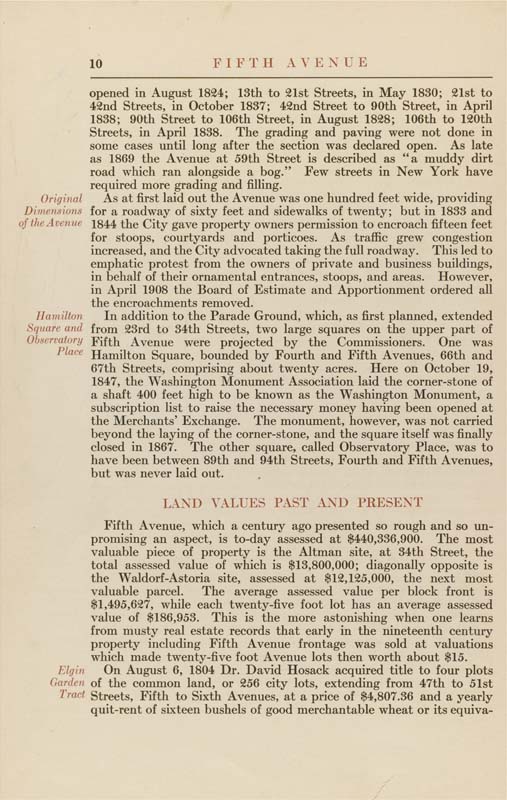10
FIFTH AVENUE
Original
Dimensions
of the Avenue
Hamilton
Square and
Observatory
Place
opened in August 1824; 13th to 21st Streets, in May 1830; 21st to
42nd Streets, in October 1837; 42nd Street to 90th Street, in April
1838; 90th Street to 106th Street, in August 1828; 106th to 120th
Streets, in April 1838. The grading and paving were not done in
some cases until long after the section was declared open. As late
as 1869 the Avenue at 59th Street is described as "a muddy dirt
road which ran alongside a bog." Few streets in New York have
required more grading and filling.
As at first laid out the Avenue was one hundred feet wide, providing
for a roadway of sixty feet and sidewalks of twenty; but in 1833 and
1844 the City gave property owners permission to encroach fifteen feet
for stoops, courtyards and porticoes. As traffic grew congestion
increased, and the City advocated taking the full roadway. This led to
emphatic protest from the owners of private and business buildings,
in behalf of their ornamental entrances, stoops, and areas. However,
in April 1908 the Board of Estimate and Apportionment ordered all
the encroachments removed.
In addition to the Parade Ground, which, as first planned, extended
from 23rd to 34th Streets, two large squares on the upper part of
Fifth Avenue were projected by the Commissioners. One was
Hamilton Square, bounded by Fourth and Fifth Avenues, 66th and
67th Streets, comprising about twenty acres. Here on October 19,
1847, the Washington Monument Association laid the corner-stone of
a shaft 400 feet high to be known as the Washington Monument, a
subscription list to raise the necessary money having been opened at
the Merchants' Exchange. The monument, however, was not carried
beyond the laying of the corner-stone, and the square itself was finally
closed in 1867. The other square, called Observatory Place, was to
have been between 89th and 94th Streets, Fourth and Fifth Avenues,
but was never laid out.
LAND VALUES PAST AND PRESENT
Fifth Avenue, which a century ago presented so rough and so un¬
promising an aspect, is to-day assessed at $440,336,900. The most
valuable piece of property is the Altman site, at 34th Street, the
total assessed value of which is $13,800,000; diagonally opposite is
the Waldorf-Astoria site, assessed at $12,125,000, the next most
valuable parcel. The average assessed value per block front is
$1,495,627, while each twenty-five foot lot has an average assessed
value of $186,953. This is the more astonishing when one learns
from musty real estate records that early in the nineteenth century
property including Fifth Avenue frontage was sold at valuations
which made twenty-five foot Avenue lots then worth about $15.
Elgin On August 6, 1804 Dr. David Hosack acquired title to four plots
Garden of the common land, or 256 city lots, extending from 47th to 51st
Tract Streets, Fifth to Sixth Avenues, at a price of $4,807.36 and a yearly
quit-rent of sixteen bushels of good merchantable wheat or its equiva-
|








